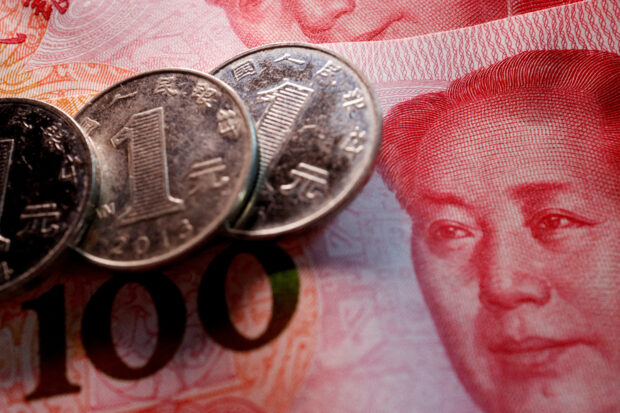China July new bank loans tumble, credit growth weakens further

Coins and banknotes of China’s yuan are seen in this illustration picture taken Feb 24, 2022. REUTERS/Florence Lo/Illustration/File photo
BEIJING –China‘s new bank loans tumbled in July and other key credit gauges also weakened, even after policymakers cut interest rates and promised to roll out more support for the faltering economy.
Chinese banks extended 345.9 billion yuan ($47.80 billion) of new yuan loans in July, tumbling 89 percent from June to the lowest since late 2009 and falling far short of analysts’ forecasts, data from the People’s Bank of China showed on Friday.
Analysts polled by Reuters had expected new loans last month to fall sharply from 3.05 trillion yuan in June to 800 billion yuan, after record lending in the first half as the central bank tried to shore up sputtering consumption and investment.
The reading was also much lower than 679 billion yuan in July 2022.
While lending in China typically tends to fall back in July for seasonal reasons, the weak credit readings come days after other grim data which showed the world’s second-largest economy slipped into deflation last month while exports and imports plummeted, adding pressure on Beijing to roll out more forceful stimulus measures.
“China’s bank loan growth fell to its lowest in seven months in July, while broad credit growth dropped to a record low,” Capital Economics said in a note to clients.
“We expect further policy rate cuts (as soon as next Tuesday) and a spike in government bond issuance in the coming months, but unless there is a wider improvement in business and household sentiment, this probably won’t lift credit growth much.”
Hobbled by weak demand at home and abroad, China‘s economic momentum has faltered in recent months despite strong bank lending in the first half.
Household loans, mostly mortgages, contracted by 200.7 billion yuan in July, after rising 963.9 billion yuan in June, as a debt crisis in the property sector deepened, while corporate loans slid to 237.8 billion yuan last month from 2.28 trillion yuan in June, central bank data showed.
China‘s top leaders pledged in late July to step up support for the economy amid the tortuous post-COVID recovery, followed by a raft of similar pledges from various government agencies. But details so far have been scant, disappointing investors.
Central bank officials have pledged to use policy tools such as reserve requirement ratio (RRR) cuts to ensure reasonably ample liquidity.
Weak credit demand
The central bank cut its benchmark lending rates in June by a modest 10 basis points, the first such reduction in 10 months. A number of analysts predict further small cuts this year, but say that may do little to turnaround the economic malaise quickly as long as consumers and companies remain in no mood to borrow.
“The poor lending data reflects weak financing demand from the real economy.” said Luo Yunfeng, an economist at Huajin Securities. “It’s not good to force companies to borrow money when they don’t need it.”
Some economists have flagged the risk of a balance sheet recession, as Chinese households and private firms build up savings and reduce borrowing and spending after three years of strict COVID curbs.
More fiscal stimulus is also expected, with local governments — many of which are already heavily indebted — being told to speed up bond issuance to fund infrastructure projects.
Broad M2 money supply grew by 10.7 percent in July from a year earlier, according to central bank data, decelerating from 11.3 percent in June and the slowest pace since April 2022. Analysts had expected it to expand by 11 percent.
Outstanding yuan loans expanded by 11.1 percent in July from the year before, the lowest so far this year, compared with 11.3 percent growth the previous month. Analysts had expected 11.3 percent growth.
Annual growth of outstanding total social financing (TSF), a broad measure of credit and liquidity in the economy, also cooled, to 8.9 percent in July from 9 percent in June.
TSF includes off-balance sheet forms of financing that exist outside the conventional bank lending system, such as initial public offerings, loans from trust companies and bond sales.
In July, TSF slumped to 528.2 billion yuan from 4.22 trillion yuan in June. Analysts polled by Reuters had predicted July TSF at 1.1 trillion yuan.